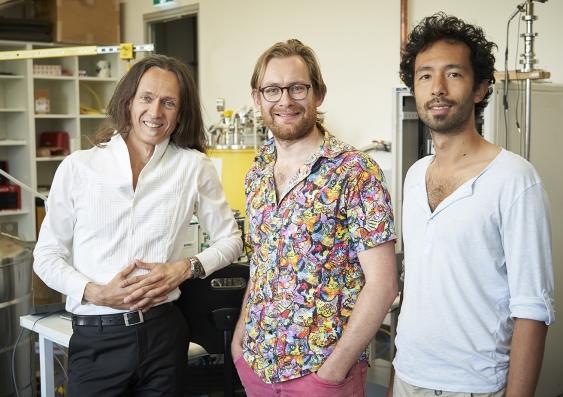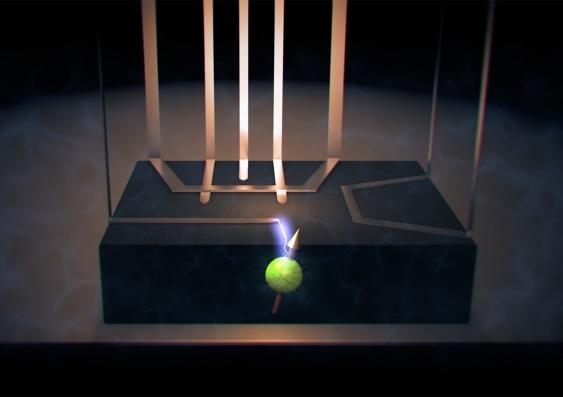58 years later, the vision of the pioneer of nuclear magnetic resonance was finally confirmed. On March 11th, 2020 local time, Nature published an article titled Coherent electrical control of a single by the team of Andrea Morello, a professor of quantum engineering science at the University of New South Wales (UNSW) in Australia. Paper on high-spin nucleus in silicon (coherent electrical control of a single high-spin nucleus in silicon).
Mistakes in an experiment unexpectedly helped the research team shake the paradigm of nuclear magnetic resonance (the theoretical basis and practical norms on which conventional science relies on operation, which is a world view and behavior that is commonly followed by a group of researchers engaged in a certain science) to achieve Breakthroughs in quantum computers and sensors.
MRI paradigm passive shake
The above paper mentioned a concept of "nuclear spin".
The chemical element we often say refers to an atom with a certain number of nuclear charges. The atom is composed of a nucleus and electrons that move around the nucleus. The so-called nuclear spin, that is, the nuclear spin angular momentum, is actually a characteristic of the atomic nucleus-the atomic nucleus is composed of protons and neutrons, and the protons and neutrons have their respective spin angular momentums, and they also have orbital movements in the nucleus. , Correspondingly has orbital angular momentum, and the sum of all these angular momentums is the spin angular momentum of the nucleus.
In fact, nuclear spins are widely used in various fields such as chemistry, medicine, materials science, and mining through magnetic resonance control and detection. At the same time, nuclear spins also appeared in early solid-state quantum computer proposals and demonstrations of quantum search and decomposition algorithms.
Substances with different magnetic properties may have different magnetic resonances under certain conditions, such as ferromagnetic resonance, ferrimagnetic resonance, antiferromagnetic resonance, nuclear magnetic resonance, etc.
"Nuclear magnetic resonance" must have been heard by most people. Nowadays, magnetic resonance imaging in medicine has become a common way of imaging examination. In fact, MRI technology is very effective in many fields, but at the same time, it still has limitations for applications in certain specific fields.
Based on this, Nicolaas Bloembergen, a pioneer of nuclear magnetic resonance and the Nobel Prize in Physics, first proposed the idea of ​​using electric fields to control a single nucleus for the first time in 1961. For half a century, this idea has not been confirmed, until recently the Andrea Morello team announced the discovery of "nuclear resonance".

[Andrea Morello team, Tuyuan UNSW official website]
In fact, this discovery has shaken the paradigm of nuclear magnetic resonance-this is because the generation of magnetic fields requires large coils and large currents. Their range of effects is very wide, and it is difficult to limit the magnetic field to a very small space; The tip of a tiny electrode can drop sharply away from the tip of the electrode. As Professor Andrea Morello said:
Magnetic resonance is like lifting the entire pool table and shaking it, thereby moving a ball on the table. The breakthrough of electric resonance is like having a billiard bat and hitting the ball accurately.
Laboratory antenna explosion is the key to success
In terms of the original intention of the research, Professor Andrea Morello said:
For more than half a century, the field of nuclear power resonance has been almost dormant. I have been studying spin resonance for 20 years. In fact, our discovery was completely accidental.
According to the UNSW official website, the research team initially performed nuclear magnetic resonance on antimony (Sb, the element has a large nuclear spin) atom. Dr. Serwan Asaad, one of the authors of the paper, explained:
Our initial goal was to explore the boundary between the quantum world and the classical world determined by the chaotic behavior of nuclear spin, driven purely by curiosity, without considering the application. But the reaction of the nucleus is very strange, there is no response at some frequencies, but at other frequencies.
This undoubtedly puzzled the research team until the research team realized that they were doing electrical resonance, not magnetic resonance.
Therefore, researchers have created a device composed of antimony atoms and a special antenna. After optimization, the device generates a high-frequency magnetic field to control the nucleus. It is reported that the experiment requires a very strong magnetic field, so the researchers input a lot of power to the antenna, so the antenna exploded.
If the research team ’s experiments used smaller atomic nuclei, such as phosphorus, the antenna was blown up, which meant that the device was unusable and the game was over.
But this "failure" happens to be the key to success-due to the use of antimony cores, a strong electric field was generated after the antenna was destroyed, and the researchers discovered nuclear power resonance.
Paving the way for silicon quantum computers
After demonstrating the ability of the electric field to control the nucleus, the researchers used microscopic theoretical models to understand how the electric field accurately affects the spin of the nucleus.
Specifically, the above model reveals how purely electrical modulation of nuclear quadrupole interactions leads to uniquely addressable coherent nuclear spin transitions due to lattice strain. Spin dephasing (referring to the rapid dispersal of coherent signals, so that unwanted residual signals are quickly attenuated, thereby reducing the impact on subsequent useful signals) Time (0.1 seconds) is a method of electrically driving by requiring electronic spin coupling The acquisition time is several orders of magnitude longer.
The above results show that, using all-electric control, high-spin quadrupole cores can be used as chaotic models, strain sensors, and spin-mechanical hybrid quantum systems. Integrating a power-controllable core with quantum dots can pave the way for a scalable, quantum-based silicon quantum computer based on nuclear and electron spins, ensuring it works without an oscillating magnetic field.
Based on this, the research team found that nuclear power resonance is a truly local microscopic phenomenon-the electric field redirects the atomic bond around the nucleus (generally refers to a chemical bond created by two atoms through the sharing of electron pairs).
Professor Andrea Morello also said:
This discovery means that there is now a way to use single atom spins to build quantum computers, without any oscillating magnetic field to run them. In addition, using these nuclei as precise electric and magnetic field sensors can answer basic questions in quantum science.
In this paper, the research team also demonstrated in detail the use of local electric fields generated in silicon nanoelectronic devices to control the quantum coherence of individual antimony nuclei.

[Using nano-scale electrodes to locally control the quantum state of single antimony nuclei in silicon wafers, source UNSW official website]
It is worth mentioning that Andrea Morello is not only a professor of quantum engineering sciences at the University of New South Wales, but also a project manager of a quantum computing and communications advanced technology center in Sydney, which relies on the University of New South Wales. Silicon Quantum Computing Pty Ltd, a quantum computing company, aims to promote the development and commercialization of quantum computers.
In September 2017, the Andrea Morello team invented a quantum computer structure based on the "spin flip qubit". This invention also greatly reduced the cost and difficulty of mass production of quantum chips. .Communications (Nature Communications) published related papers.
Professor Andrea Morello also said:
We plan to develop a 10-qubit silicon-based integrated circuit chip by 2022, which will be the first step towards the world's first silicon quantum computer.
Power Tools are hand-held, transportable electric tools in which motor is inseparable part of the machine. Examples of conventional electrically power tools are screwdrivers, drills, routers, sanders and a variety of saws, such as jigsaws, reciprocating saws and circular saws. Compared to hand tools, Power tools can help you to complete home repair and large-scale projects with speed, ease and safety.
Power Tools
Power Tools,Cordless Drill,Angle Grinder, Rotary hammer
AWLOP CO.,LTD , https://www.awlop.com